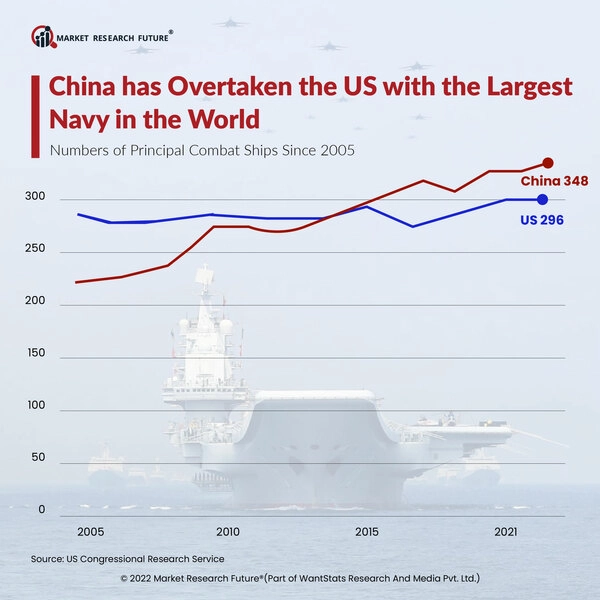US Military Strength Vs. China's Growing Military-Industrial Complex

Table of Contents
US Military Advantages
The US military boasts several significant advantages stemming from decades of investment, technological innovation, and global partnerships.
Technological Superiority
The US military maintains a technological edge across multiple domains.
-
Superior airpower: The US Air Force possesses a fleet of advanced fighter jets, including the F-22 Raptor and F-35 Lightning II, featuring stealth technology providing a significant advantage in air superiority. This technological leap allows for unparalleled precision strikes and reduced vulnerability to enemy defenses. The development and deployment of next-generation fighter aircraft continues to solidify this dominance in the air.
-
Advanced naval capabilities: The US Navy operates the world's largest and most powerful fleet, including numerous aircraft carriers, nuclear-powered submarines, and advanced destroyers. These assets enable power projection globally and the ability to respond rapidly to crises across the globe. The sheer scale of this naval power ensures control of key sea lanes and strategic choke points.
-
Sophisticated missile defense systems: The US invests heavily in missile defense systems, such as the Ground-Based Midcourse Defense (GMD) system, designed to protect against ballistic missile threats. This robust defense layer is critical in deterring potential adversaries. Ongoing research and development ensures these systems remain at the forefront of defensive technology.
-
Global network of military bases and alliances: The US military maintains a vast network of military bases across the globe, providing logistical support and strategic positioning. Strong alliances with NATO, Japan, South Korea, and other key partners enhance interoperability and expand its global reach. These alliances allow for combined military exercises and rapid deployment of forces when necessary.
-
US military budget significantly larger than China's, allowing for greater investment in R&D. This consistent high level of funding fuels continuous innovation across all branches of the military.
-
Decades of experience in large-scale military operations and conflict resolution. This practical experience provides invaluable knowledge and expertise in managing complex military engagements.
Global Reach and Alliances
The US military's global reach is unmatched.
-
Extensive network of military bases worldwide: This global network allows for rapid deployment of forces and logistical support for operations around the world. The strategic placement of these bases provides a significant advantage in projecting power.
-
Strong alliances with key nations (NATO, Japan, South Korea): These alliances provide access to crucial resources, intelligence sharing, and combined military capabilities. These partnerships significantly amplify the US military’s reach and effectiveness.
-
Ability to project power globally: This capability is crucial in maintaining global stability and responding to crises anywhere in the world. This projection of power is a key element of US foreign policy.
-
Established command and control structures and interoperability among allies. These structures and interoperability are essential for efficient and effective coordinated military operations.
-
Access to crucial resources and logistical support networks worldwide. This worldwide access underpins the ability to sustain prolonged military operations in remote locations.
China's Military Expansion and Challenges
While the US maintains significant advantages, China's military modernization poses a growing challenge.
Rapid Modernization
China has invested heavily in modernizing its military.
-
Significant investment in military modernization and technological development: This commitment reflects China's ambitions for regional and global influence. The scale of this investment is rapidly bridging the technological gap.
-
Focus on anti-access/area denial (A2/AD) capabilities: China is developing capabilities to deter potential adversaries from entering its territorial waters or airspace. This strategic focus aims to restrict US military operations in the region.
-
Development of advanced weaponry (hypersonic missiles, drones): China is making rapid progress in developing advanced weaponry, challenging the US technological edge in certain areas. These advancements are significantly altering the balance of power.
-
Growing naval power, including expansion of aircraft carrier fleet and submarine capabilities: This naval expansion is directly aimed at challenging US naval dominance in the Asia-Pacific region.
-
Investment in space-based capabilities and cyber warfare: China is actively developing space and cyber warfare capabilities, representing a significant challenge to US military dominance.
Limitations and Challenges
Despite rapid modernization, China faces several limitations.
-
Limited combat experience compared to the US military: Lack of extensive combat experience may hinder the effectiveness of its military in large-scale conflicts.
-
Challenges in projecting power beyond its immediate region: China's military logistical capabilities are still developing and pose limitations on its global power projection capabilities, unlike the US military.
-
Dependence on foreign technology in certain areas: This dependence creates vulnerabilities and can be exploited by adversaries. The reliance on foreign technology is a strategic weakness.
-
Potential vulnerabilities in its supply chains. Disruptions to supply chains could severely impact military readiness.
-
Concerns regarding human rights and its treatment of ethnic minorities, impacting international relations. These concerns can negatively influence international alliances and partnerships, impacting its military's global reach.
Comparative Analysis: Key Areas of Contestation
Understanding the current military balance requires a comparative analysis across key domains.
Naval Power
A direct comparison of carrier strike groups, submarine fleets, and littoral combat capabilities reveals a significant gap in overall numbers, but China's advancements in submarine technology and anti-ship capabilities are narrowing the gap, posing a notable threat to US naval dominance in the region.
Air Power
Comparing stealth fighter jets, bomber fleets, and air defense systems reveals a current US advantage in terms of technology and overall fleet size. However, China's rapid development and production of its own advanced fighter jets are steadily reducing the technological gap.
Cyber Warfare and Space Capabilities
Both nations possess significant capabilities in cyber warfare and space-based assets. The competition in these domains is intense and constantly evolving, with each nation striving to gain an advantage in this critical area of modern warfare.
Nuclear Deterrence
Both the US and China possess significant nuclear arsenals. The strategic implications of these arsenals and their potential use are a key component of the overall power dynamic between the two nations. Nuclear deterrence plays a vital role in the global power balance.
Conclusion
The comparison between the US military and China's growing military-industrial complex reveals a complex and evolving landscape. While the US currently retains significant advantages in technological superiority and global reach, China's rapid modernization poses a serious challenge. The future balance of power will likely depend on continued technological advancements, strategic partnerships, and the successful navigation of geopolitical tensions. Understanding the nuances of US Military vs China Military is critical for policymakers and citizens alike. Further research and ongoing analysis are vital to navigating this shifting global landscape. Continue learning about the intricate dynamics of US Military vs China Military to stay informed on this critical geopolitical issue.

Featured Posts
-
 Analyse De L Impact De L Ingenierie Castor Sur Deux Cours D Eau De La Drome
May 31, 2025
Analyse De L Impact De L Ingenierie Castor Sur Deux Cours D Eau De La Drome
May 31, 2025 -
 Bodensee In Gefahr Verschwindet Der See In 20 000 Jahren Klimaschutz Weiterhin Notwendig
May 31, 2025
Bodensee In Gefahr Verschwindet Der See In 20 000 Jahren Klimaschutz Weiterhin Notwendig
May 31, 2025 -
 Nyt Mini Crossword May 1 Solving The Marvel The Avengers Clue
May 31, 2025
Nyt Mini Crossword May 1 Solving The Marvel The Avengers Clue
May 31, 2025 -
 Duncan Bannatyne Condemns Men In Womens Changing Rooms Following Supreme Court Ruling
May 31, 2025
Duncan Bannatyne Condemns Men In Womens Changing Rooms Following Supreme Court Ruling
May 31, 2025 -
 Luxury Hotel Stays Save Up To 30 This Spring
May 31, 2025
Luxury Hotel Stays Save Up To 30 This Spring
May 31, 2025
